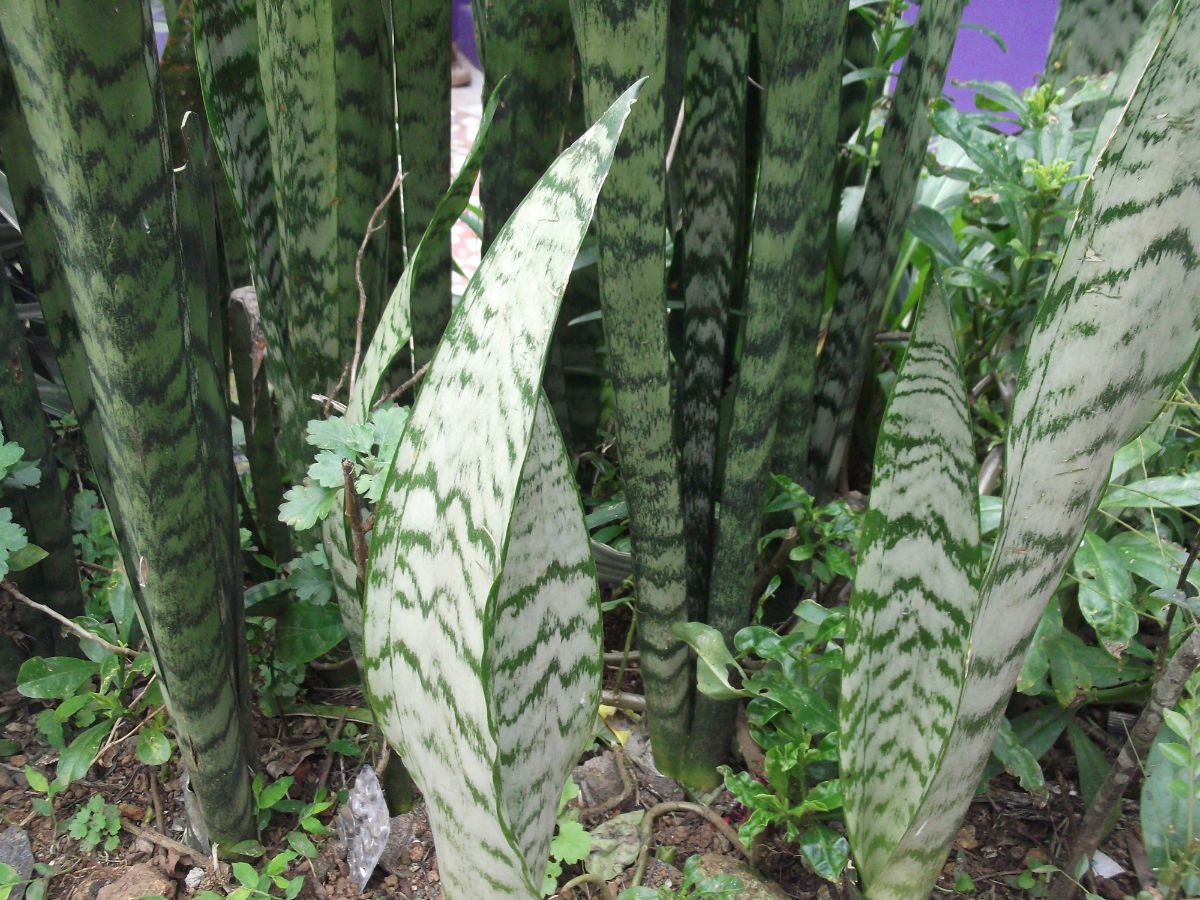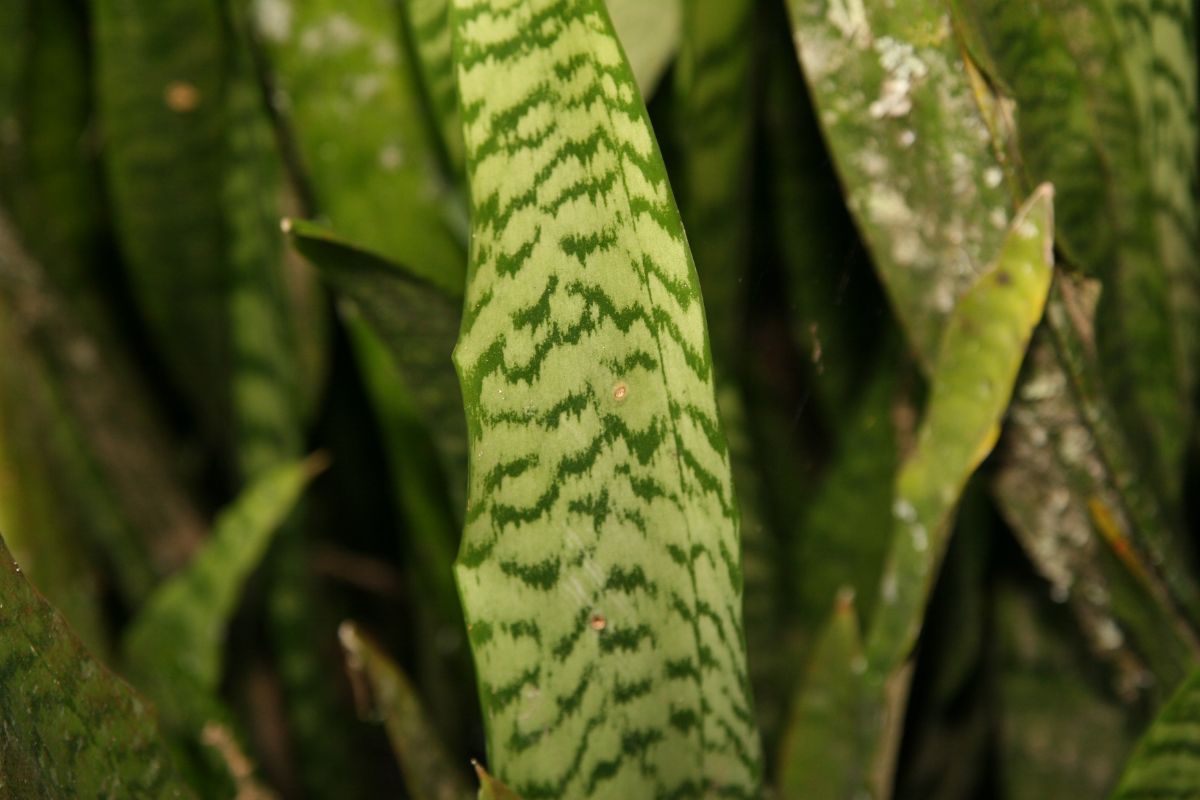
The Sansevieria zeylanica, also known as Dracaena zeylanica, or devil's tongue, is one of the most used plants for interior decoration. It is seen in houses, restaurants, hotels... due to its great resistance.
But what is the Sansevieria zeylanica like? What care do you need? Are there curiosities about the plant? Next we are going to give you all the information you need to know about it.
How is the Sansevieria zeylanica

Devil's tongue, dracaena zeylanica, sansevieria trifasciata zeylanica, mother-in-law's tongue, snake plant or Saint George's sword. All these names refer to the same plant, the Sansevieria zeylanica.
It is a plant native to tropical Africa but can also be found in Sri Lanka and India.
Physically, it is a plant made up of leaves that grows up to about 30 centimeters tall. They usually grow in clusters of 8-15 leaves and are light green with dark green spots. These are rounded on the underside and on the upper side they have a kind of channel.
In addition to the leaves, we must also take into account the flowers. Because yes, it throws flowers. We usually talk about a stem that can double the height of the leaves, that is to say, about 60 centimeters in which, by way of clusters, pale-colored flowers (almost always white) will come out. If you manage to have them in your Sansevieria zeylanica, you will also enjoy a sweet smell emanating from them.
Sansevieria zeylanica care

Now that you know a little more about Sansevieria zeylanica, it's time to focus on its general care, those that can help your plant develop and grow.
Lighting and location
About the Sansevieria zeylanica it is said that it is capable of adapting to any place, whether inside or outside the home. But in reality, it must be taken into account that, ideally, it would be an area where it received good lighting. Even direct sun in the early or late morning and afternoon.
That said, the best location for this plant is a sunny place that receives several hours of light, even direct, to grow better and maintain that color in its leaves.
Temperature
We are not going to tell you that it will endure everything, because it is not like that. Its ideal temperature would be between 16 and 21ºC. But that does not mean that it does not tolerate the most extreme heat, or the intense cold.
In fact, it can withstand frost, but it is soft. If they are very intense or last a long time, it is best to protect it so that you do not lose it.
Substratum
As for the soil that you will need, you should try to make it as drained as possible. That is to say, that the roots are kept as oxygenated as possible to also avoid accumulations of water.
Therefore, it is best that use cactus and succulent soil, to which you add perlite, akadama or any other that prevents that substrate from caking.
Irrigation
As a good sansevieria that it is, irrigation is one of the care that should be given less importance. And it is that the Sansevieria zeylanica It is watered very little and very occasionally.
The signal that your plant needs water is given by the leaves. When these are a little wrinkled you have to water it. To give you an idea, it may be the case that do not need watering more than every 2-3 months.
Humidity
Many times we have commented that irrigation is not as important as humidity. In this case, the Sansevieria zeylanica does not need moisture either. In fact, it is better to have it in a dry ambient humidity than in a medium or high humidity.
The reason why we tell you this is because the leaves retain a lot of water, and if the humidity also affects it, it can end up rotting it.
Plagues and diseases
The Sansevieria zeylanica is quite resistant to both pests and diseases. However, that is not to say that they do not affect you.
Regarding illnesses, the most common ones that can affect you are due to excess of water. The symptoms that warn of this problem are that the leaves will be soft, with brown spots (of rot) and drooping (when it is normal for them to be erect).
In the case of pests, the most common is the cottony mealybug, which will have to be removed from the leaves so that they do not get sick.
Subscriber
The fertilizer that you should use for Sansevieria zeylanica is that of succulents and succulents. It is recommended to follow the instructions that come in the boat, but we recommend you lower it a bit.
In addition, it is better to fertilize all year than not to stop in winter. Of course, it should be with half the dose to avoid problems. In this way your plant will be much better nourished.
Reproduction
Finally, we are left with the reproduction or multiplication of the Sansevieria zeylanica. In this case, the easiest is to do it by rhizome division, that is, dividing the plant by stems and separating them carefully.
Another way to do it that they use a lot is cutting a leaf, as close to the base as possible, and putting it in water. In a matter of a few weeks it should start to take root and you can have a new plant in a few months.
How to get it to give flowers
As we have told you before, making this plant flourish is not easy to achieve. The truth is that very few have seen these flowers, especially if you have it indoors. But it does not mean that it is impossible.
The best thing is to meet all the needs of the plant and if possible have it outdoors in a temperate climate so that it adapts to the cycles. Maybe not the first year, but it is possible that the second or third year you can find this surprise.
Curiosities

One of the main curiosities that Sansevieria zeylanica has is the fact that NASA itself has noticed it. In fact, it was this one that declared that the plant was an air purifier.
What it does is remove both benzene and formaldehyde from the environment to make it cleaner. Hence, in many houses this plant is present.
Do you know more about Sansevieria zeylanica? You can tell us about them in the comments.